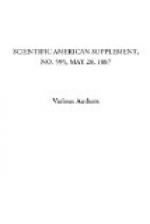Our confrere Ruhlmann, of the Elektrotechnische Zeitschrift, gives a still more remarkable example yet of such confusion. The word polarization, borrowed from optics, where it has an unequivocal sense, serves likewise to designate the development of the counter electro-motive force of galvanic elements, and also that essentially different condition of badly conducting substances that is brought about by the simultaneous influence of quantities of opposite electricity.
In Germany, the word induction, coupled with the word wire, for example, according to the formation of compound words in that language, may also have a double meaning, and it is by the sense alone of the phrase that we learn whether we have to do with an induced wire or an inducting one. The examples might be multiplied.
At its session of November 5, 1884, the International Society of Electricians, upon a motion of Mr. Hospitalier, who had made a communication upon this question, appointed a committee to study it and report upon it. The English Society of Electricians likewise took the subject into consideration, and one of its most active and distinguished members, Mr. Jamieson, presented the result of his labors at the May session of the society in 1885.
A discussion arose in which the committee of the International Society of Electricians was invited to take part. The committee was represented by its secretary, Mr. Hospitalier, who expressed himself in about these words: “The committee on electric notations presided over by Mr. Blauvelt has finished a part of its task, that relative to abbreviations, notations, and symbols. It will soon take up the second part, which relates to definitions and agreements.” He broadly outlined the committee’s ideas as follows:
In all physical magnitudes that are made use of, we have: (1) the physical magnitude itself, aside from the units that serve to measure it; (2) the C.G.S. unit that serves to measure such grandeur (granted the adoption of the C.G.S. system); (3) practical units, which, in general, have a special name for each kind of magnitude, and are a decimal multiple or sub-multiple of the C.G.S. unit, except for time and angles; (4) finally, decimal multiples and sub-multiples of these practical units, that are in current use.
The committee likewise decided always to adopt a large capital to designate the physical magnitude; a small capital to designate the C.G.S. unit, when it has a special name; a “lower case” letter for the abbreviation of each practical unit; and prefixes, always the same, for the decimal multiples and sub-multiples of the practical units.
Thus, for example, work would be indicated by the letter W (initial of the word); the C.G.S. unit is the erg, which would be written without abbreviation, on account of its being short; and the practical units would be the kilogrammeter (kgm), the grammeter (gm), etc. The multiples would be the meg-erg, the tonne-meter (t-m), etc.




